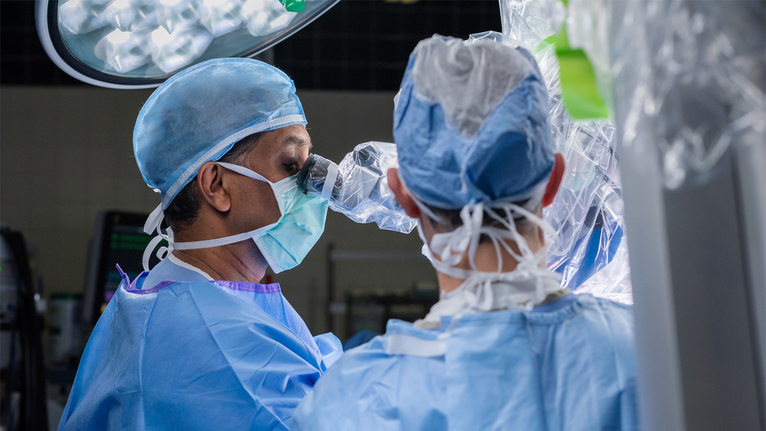Skull Base Tumors, Diseases and Conditions that UC Health Treats
UC Health skull base experts are equipped to treat some of the most complex conditions from all three regions of the skull base – the anterior, the middle and the posterior. Some of the conditions we treat include:
- Acoustic neuroma (vestibular schwannomas).
- Angiofibroma.
- Cerebrospinal fluid (CSF) leaks.
- Chondrosarcoma.
- Chordoma.
- Craniopharyngioma.
- Facial nerve tumors.
- Glomus tumors.
- Malignant peripheral nerve sheath tumors.
- Meningioma.
- Neurofibromatosis type 2 (NF2).
- Pituicytoma.
- Pituitary tumors.
- Rathke’s cleft cysts.
- Sinonasal malignancies.
- Skull base trauma.
- Temporal bone cancer.
Common Skull Base Tumor Symptoms
All of the conditions noted above have their own set of symptoms, but generally speaking, if a skull base tumor is present, cancerous or not, it places pressure on vital areas of the brain, which may cause:
- Headaches.
- Blurred or double vision.
- Hearing loss.
- Discharge from the ear (otorrhea).
- Ear pain (otalgia).
- Trouble breathing and swallowing.
- Loss of balance/dizziness.
Most of these symptoms present themselves slowly over the course of time. It is imperative to stay in tune to your body, and to see a physician as soon as any of these symptoms begin to impact your normal daily functions.
UC Health’s Care Approach for Skull Base Patients
“Our care approach is simple: patients first,” said Ahmad Sedaghat, MD, PhD, director of rhinology, allergy and anterior skull base surgery at UC Health and associate professor in the Department of Otolaryngology-Head and Neck Surgery at the UC College of Medicine.
The skull base program includes a multidisciplinary team of neurosurgeons, neurotologists, rhinologists, otolaryngologists, endocrinologists, oncologists, radiologists and pathologists. These subspecialty-trained skull base experts work collaboratively with each patient to develop a patient-centric, individualized care plan unique to the patient’s condition, disease or tumor of the skull base.
“Our skull base program is also supported by a team of specialized nurses, social workers and ancillary personnel that help patients and their families navigate through all stages of their customized care plan,” Dr. Sedaghat continued.
The benefit of going to an academic medical center for skull base treatment
At an academic health system, like UC Health, teams of physicians, nurses, researchers and educators all work together to provide patients access to some of the latest medical breakthroughs and leading-edge treatments for skull base conditions, including auditory brainstem implants, cerebrovascular surgery, cochlear implants, endoscopic endonasal surgery, transsphenoidal pituitary surgery, proton beam therapy and skull base surgery to remove tumors.
“We compete against top-notch academic centers from across the state, region and nation,” said Norberto Andaluz, MD, director of skull base surgery at UC Health and professor in the Department of Neurosurgery at the UC College of Medicine. “Our skull base team can provide patients access to some of the newest medical discoveries and techniques, some of which come from our own research and innovation.“
In addition, UC Health has an established skull base surgery research lab solely focused on developing the latest advancements in safe and effective skull base surgery.
“Our most recent research focuses on the use of image-guided technology and 3D printing to more effectively and safely visualize surgical pathways and corridors,” Dr. Andaluz continued. “With the complexities of the skull base region, this research provides our team with the ability to better understand and prepare for complex skull base surgeries.”
Procedures or Techniques Pioneered by UC Health Skull Base Experts
For almost 40 years, our subspecialty team of skull base experts have worked collaboratively to develop a number of innovative surgical techniques that push the boundaries of what can be done safely and less invasively to improve the quality of care for our patients. Some of these advancements include the development of:
- Endoscopic approaches to the cavernous sinus.
- Open skull base techniques and bypass surgery.
- Original modifications to classic skull base approaches.
- First eyelid approach to anterior skull base.
- The first program in the world to place auditory brainstem implants through three different approaches (middle cranial fossa, translabyrinthine and retrosigmoid).
“It’s through research and innovation like this that we are able to diagnose and treat patients sooner,” Dr. Samy explained. “Innovations we pioneered have ultimately resulted in less invasive interventions and fewer challenges for the patient to get back to their normal life.”

